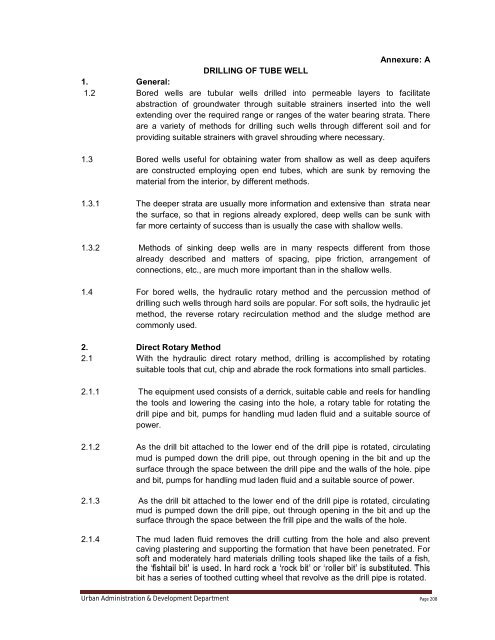Specifications Part 1 - Water Supply, Sewerage and Tube Well Works
Specifications Part 1 - Water Supply, Sewerage and Tube Well Works
Specifications Part 1 - Water Supply, Sewerage and Tube Well Works
You also want an ePaper? Increase the reach of your titles
YUMPU automatically turns print PDFs into web optimized ePapers that Google loves.
Annexure: ADRILLING OF TUBE WELL1. General:1.2 Bored wells are tubular wells drilled into permeable layers to facilitateabstraction of groundwater through suitable strainers inserted into the wellextending over the required range or ranges of the water bearing strata. Thereare a variety of methods for drilling such wells through different soil <strong>and</strong> forproviding suitable strainers with gravel shrouding where necessary.1.3 Bored wells useful for obtaining water from shallow as well as deep aquifersare constructed employing open end tubes, which are sunk by removing thematerial from the interior, by different methods.1.3.1 The deeper strata are usually more information <strong>and</strong> extensive than strata nearthe surface, so that in regions already explored, deep wells can be sunk withfar more certainty of success than is usually the case with shallow wells.1.3.2 Methods of sinking deep wells are in many respects different from thosealready described <strong>and</strong> matters of spacing, pipe friction, arrangement ofconnections, etc., are much more important than in the shallow wells.1.4 For bored wells, the hydraulic rotary method <strong>and</strong> the percussion method ofdrilling such wells through hard soils are popular. For soft soils, the hydraulic jetmethod, the reverse rotary recirculation method <strong>and</strong> the sludge method arecommonly used.2. Direct Rotary Method2.1 With the hydraulic direct rotary method, drilling is accomplished by rotatingsuitable tools that cut, chip <strong>and</strong> abrade the rock formations into small particles.2.1.1 The equipment used consists of a derrick, suitable cable <strong>and</strong> reels for h<strong>and</strong>lingthe tools <strong>and</strong> lowering the casing into the hole, a rotary table for rotating thedrill pipe <strong>and</strong> bit, pumps for h<strong>and</strong>ling mud laden fluid <strong>and</strong> a suitable source ofpower.2.1.2 As the drill bit attached to the lower end of the drill pipe is rotated, circulatingmud is pumped down the drill pipe, out through opening in the bit <strong>and</strong> up thesurface through the space between the drill pipe <strong>and</strong> the walls of the hole. pipe<strong>and</strong> bit, pumps for h<strong>and</strong>ling mud laden fluid <strong>and</strong> a suitable source of power.2.1.3 As the drill bit attached to the lower end of the drill pipe is rotated, circulatingmud is pumped down the drill pipe, out through opening in the bit <strong>and</strong> up thesurface through the space between the frill pipe <strong>and</strong> the walls of the hole.2.1.4 The mud laden fluid removes the drill cutting from the hole <strong>and</strong> also preventcaving plastering <strong>and</strong> supporting the formation that have been penetrated. Forsoft <strong>and</strong> moderately hard materials drilling tools shaped like the tails of a fish,bit has a series of toothed cutting wheel that revolve as the drill pipe is rotated.Urban Administration & Development Department Page 208
















